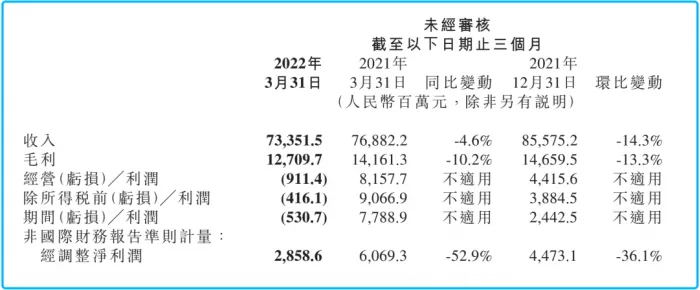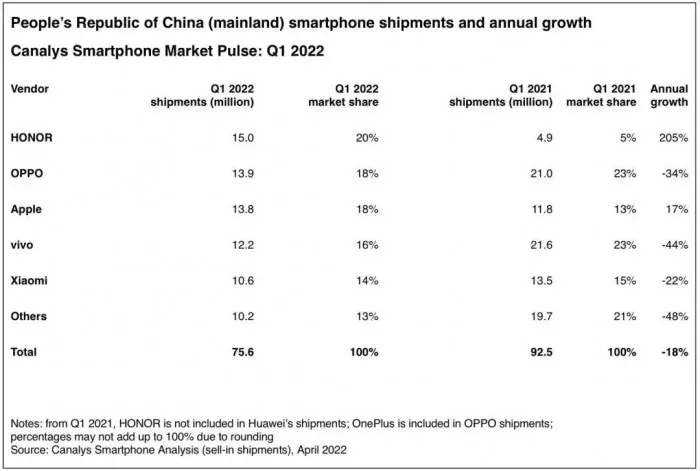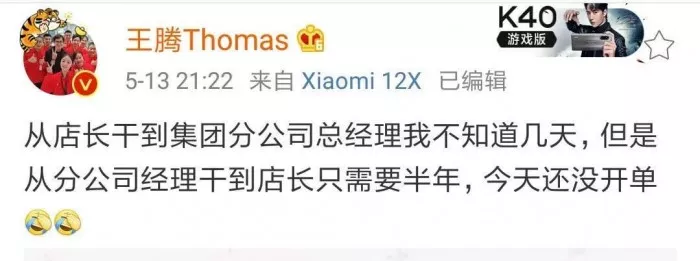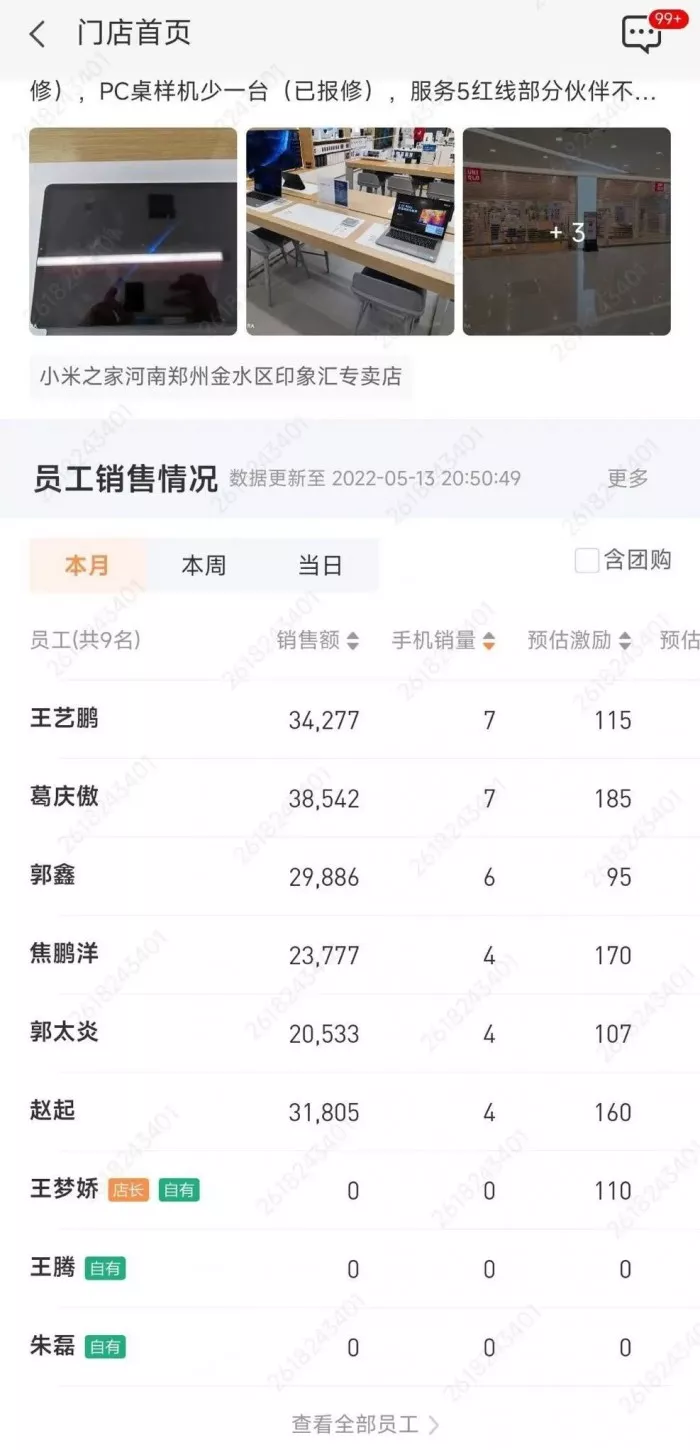The mobile phone business is sluggish, facing the problem of pressing goods, the effect of offline channel stores does not meet expectations, the share price falls below the issue price again, and the car manufacturing business is slow... Xiaomi still wants to win the first place in the market share of domestic high-end mobile phones in three years "In the first quarter of 2022, Xiaomi achieved a revenue of 73.352 billion yuan, a year-on-year decrease of 4.6%; a loss of 531 million yuan during the period, a profit of 7.789 billion yuan in the same period last year; and an adjusted net profit of 2.859 billion yuan, a year-on-year decrease of 52.9%."
This is the answer sheet submitted by Xiaomi in the first quarter of this year.

The decline in performance is related to the sluggish smartphone business. Wang Xiang, President of Xiaomi, revealed in a conference call that the shortage of low-end chips in the first quarter posed a challenge to the shipment of Xiaomi mobile phones, but this situation will be improved in the second quarter.
The quarterly mobile phone business of Xiaomi has become the main starting point of the overseas mobile phone market. In the first quarter of 2022, the overseas market revenue of Xiaomi group was 37.5 billion yuan, accounting for 51.1% of the total revenue. The shipments of smart phones from overseas market operators exceeded 5.7 million, with a year-on-year increase of more than 10%.
In this quarterly report, the most outstanding business is the Internet of things and consumer products business. In the first quarter of this year, the revenue reached 19.5 billion yuan, a year-on-year increase of 6.8%; The gross profit margin rose 14.5 percentage points year-on-year to 15.6%, a record high in a single quarter.
"At present, Xiaomi group has more than 10000 offline stores. More and more consumers choose Offline stores to buy Internet of things products, and the proportion of revenue from non mobile hardware continues to rise." Said Wang Xiang.
In terms of Internet services, the revenue of Xiaomi's business segment increased to 7.1 billion yuan from 6.6 billion yuan in the same period last year, a year-on-year increase of 8.2%, mainly due to the growth of advertising revenue. Specifically, the number of overseas Internet users of Xiaomi continued to grow, and the overseas Internet service revenue increased by 71.1% to 1.6 billion yuan from 900 million yuan in the same period last year.
For the Indian market that has attracted much attention, Wang Xiang said that Xiaomi group is a very legal and compliant enterprise. Its taxes and expenses are carried out in strict accordance with the laws and relevant regulations of the host country, and there is no problem of violation. At present, relevant Indian departments have lifted the freeze on the company's US $725 million funds, and Xiaomi will continue to maintain frank communication with India in the hope of reaching a consensus.
On February 8 this year, Lei Jun held a high-end strategy seminar with senior executives of the group and general managers of relevant business departments. At the meeting, Lei Jun defined the impact on high-end as "the battle of life and death for the development of Xiaomi", and shouted the goal of winning the first market share of domestic high-end mobile phones within three years.
However, according to people familiar with the matter, Xiaomi is facing the problem of pressing mobile phones.
For the dynamics of car making, Xiaomi said that it is continuously investing resources in the research and development of core technologies in cars, but there is not much progress that can be announced at present.
It's not easy for technology stocks in 2022. Xiaomi experienced a big rise and fall in the first two years, and its share price fell below the issue price again in January this year, ushering in the low level since its listing. In the low position of Xiaomi, can it perform another big reversal? Win this "battle of life and death"?
1
Smartphone under pressure
Smartphone manufacturers are experiencing a new round of cold winter, and Xiaomi is no exception.
According to the first quarter report of Xiaomi in 2022, in the first quarter of this year, Xiaomi's smartphone business revenue was 45.8 billion yuan, down 11% from 51.5 billion yuan in the same period last year; Xiaomi's global smartphone market shipped 38.5 million units, down 21.4% from 49 million units in the same period last year.
A few hours before the release of Xiaomi's quarterly report, a message that "Xiaomi, oppo and vivo have informed suppliers that they will cut orders by about 20% in the next few quarters" spread on major platforms.
During the teleconference that night, Wang Xiang did not directly respond to the authenticity of the news, but he admitted that affected by the epidemic, the uncertainty of the international situation and the shortage of low-end chip supply, some stores of Xiaomi were closed, which brought difficulties to Xiaomi's performance in the first quarter.
"At present, the global smartphone market is declining, and it is not easy to achieve such results against this background. However, Xiaomi should learn to deal with uncertainty and carefully predict its goals this year." Said Wang Xiang.
A person familiar with Xiaomi's mobile phone industry disclosed that Xiaomi's original annual shipment target was 190 million units, which has been reduced to 150 million units
Ten years ago, Lei Jun told the media that his most painful thing was to predict future sales. "If it's not easy to sell mobile phones, we will press the goods. Once we press the goods, our funds will be overstocked and may be finished," he said
Ten years later, Xiaomi still needs to face the problem of pressing mobile phones.
"Take the folding screen as an example. There should have been hundreds of thousands of forecast before. Now there are still a lot of inventory." A person familiar with the matter said that unlike conventional mobile phones, folding screen mobile phones use customized materials rather than general materials. Once the inventory is overstocked, it is very troublesome to deal with it.
Not only are high-end mobile phones facing the problem of inventory backlog, but red rice, which is famous for its cost performance, has also encountered this problem.
On March 17 this year, red rice released redmi K40S, priced from 1799 yuan to 2399 yuan. This mobile phone, which should have impulse, did not meet Xiaomi's expectations.

Source: Lei Jun microblog
"The sales volume of redmi K40S in the first week is only 18000 units, and the usual price range of mobile phones (sales volume in the first week) is at least 100000 units. 18000 units are too few. The stock of this model needs 5 million units to see if it can be pulled up in the back." The aforementioned insider said.
In fact, the performance of Xiaomi mobile phone in the first quarter is also a reflection of the whole mobile phone industry.
Due to the impact of the epidemic situation, the uncertainty of the international situation, the longer season change cycle and the shortage of supply chain, the smartphone industry as a whole is under pressure, and the global smartphone market is declining.
According to the latest report of canalys, a market analysis agency, in the first quarter of 2022, global smartphone shipments fell by 11% year-on-year. According to the report of China Academy of communications and communications, from January to March this year, the overall shipment of mobile phones in the domestic market was 69.346 million, a year-on-year decrease of 29.2%.

2
The high-end achievements are beginning to show, and offline efficiency still needs to be improved
Xiaomi has declared its high-end goal more than once, and Lei Jun has repeatedly said that the high-end road is the only way for Xiaomi to grow and the battle of life and death for Xiaomi's development.
In February this year, Lei Jun Weibo said that under the guidance of the strategy of "No. 1 mobile phone sales in the world in three years", Xiaomi products and experience should be fully benchmarked iPhone , won the first market share of domestic high-end mobile phones in three years. This is regarded by the outside world as Lei Jun's official benchmarking Apple Advanced version of.
From the quarterly report, Xiaomi's high-end has achieved preliminary results: in the first quarter of this year, the average selling price of Xiaomi's global smartphone (ASP) increased by 14.1% year-on-year to RMB 1189. The global shipments of high-end smart phones priced at 3000 yuan or more in Chinese Mainland and 300 euros or more abroad reached nearly 4million.
"The proportion of medium and high-end smartphone shipments in the total smartphone shipments has increased." Lin Shiwei, Xiaomi CFO, said in a conference call.
However, the gross margin of Xiaomi smartphone decreased to 9.9% from 12.9% in the first quarter of last year. In response to this problem, Xiaomi explained in the quarterly report that it was mainly due to the promotion of several smartphone models.
However, in Lin Shiwei's view, this is a "normal level." in the first quarter of last year, due to the shortage of goods, the company did not carry out too many product promotions, resulting in a high gross profit margin. The data in the first quarter of this year returned to the normal level, which is close to the data in the fourth quarter of last year. At the same time, Xiaomi is also cleaning up the inventory of old products, alleviating the problem of core shortage and rhythm, and hopes to continue to maintain the health of gross profit margin this year. "
Last year, Lu Weibing, vice president of Xiaomi group, President of China and general manager of redmi brand, introduced through an open letter that Xiaomi should vigorously layout the strategy of offline channels. It is undeniable that offline channels have become an important part of Xiaomi's high-end strategy.
Layout for more than a year, Xiaomi's offline channel layout has made great progress in quantity. As of March 31 this year, Xiaomi had more than 10500 offline retail stores in Chinese Mainland.
However, the driving effect of offline stores on Xiaomi business still needs a question mark.
According to the data of canalys, a market research agency, Xiaomi ranked fifth in the shipment volume of China's smartphone market in the first quarter of 2022, but Xiaomi mentioned in its quarterly report that its online market share in the first quarter was still the first. Does this mean that the effect of more than 10500 offline stores under Xiaomi line has not reached the expectation?
A person familiar with Xiaomi revealed that Xiaomi was very passive about opening a store without increasing efficiency. "The purpose of offline channels is to let social forces help brands sell mobile phones. Xiaomi wants to grab the plate of OV, but it doesn't get the increment."
In the view of another mobile phone industry practitioner, the asset investment of Xiaomi home is too heavy, and the cost of opening a store is as high as hundreds of thousands, but Xiaomi's profit sharing to customers is not generous enough, which also leads to customers' lack of motivation to help Xiaomi distribute.
Last week, the microblog of Wang Teng, general manager of Xiaomi Henan Branch, also confirmed the views of the above practitioners. On May 13, after experiencing in an offline Xiaomi home store in Henan Province, Wang Teng posted the sales statistics of store employees online. It can be seen from the screenshot that the Xiaomi home has 9 employees including Wang Teng. Among them, the employee with the highest sales sold 7 mobile phones, with sales of 38542 yuan and estimated incentive of 185 yuan.


Source: Wang Teng microblog
"This quarter, more than 50% of Xiaomi's high-end smartphones were sold through offline channels, which also proves that offline stores have brought us new users, which is the positive impact of offline channels on our business. We have 10000 stores, and how to improve store efficiency is the main goal this year," Wang Xiang said in a telephone conference
3
The vehicle delivery schedule remains unchanged
On the Xiaomi investor's day six months ago, Lei Jun said that the car building progress exceeded expectations. Xiaomi car will be officially mass produced in the first half of 2024, and the specific progress of car building will be pushed back internally according to this time point.
According to media reports, the general manager of Baojin Xiaomi Automobile Co., Ltd. will appear in the third quarter of this year.
In the teleconference on May 19, Wang Xiang said that Xiaomi is continuously investing resources in the research and development of core technologies in automobiles. At present, Xiaomi has not made much progress that can be announced. However, he also said: at present, the scale of engineers in Xiaomi automobile team has reached more than 1200, and the original delivery plan remains unchanged, that is, it is still expected to be officially mass produced in the first half of 2024.
According to the quarterly report, in the first quarter, Xiaomi spent 425 million yuan on innovative businesses such as intelligent electric vehicles.
On March 30, 2021, Xiaomi issued an announcement at the Hong Kong stock exchange, announcing that the board of directors officially approved the project of intelligent electric vehicle and established a wholly-owned subsidiary. On the same day, Lei Jun officially announced the car at the press conference on the same day and personally served as the CEO of Xiaomi intelligent electric vehicle business.
Since the official announcement, Xiaomi has rarely taken the initiative to announce the car making progress, but "registered trademark, digging people, site selection" and other disturbances related to Xiaomi's car making can attract the attention of the market.
The latest news is that, entrusted by Xiaomi officially, the relevant bidding agency company released the recruitment announcement of suppliers for Xiaomi automobile whole vehicle welding line project. According to the bidding conditions, the project is located in Shanghai, and has been approved by the project approval, approval and filing authorities, and has officially entered the stage of public bidding.
This information was interpreted by the outside world as that Xiaomi automobile would open a second factory in Shanghai, but then the official refuted the rumor that it was a misunderstanding. According to insiders of Xiaomi, it only entrusted a Shanghai bidding company to conduct bidding for relevant projects, rather than building a factory in Shanghai.
On April 1, 2021, Xiaomi Technology Co., Ltd. applied to register the trademark of "Xiaomi automobile".
Subsequently, Lei Jun took the lead in organizing an industry gathering. There were many founders of new domestic car manufacturing forces such as he Xiaopeng, Li Bin and Li Xiang, as well as the founders of traditional car enterprises. After the gathering, Lei Jun visited the R & D and manufacturing centers of Dongfeng, Chang'an, great wall, GAC, SAIC and other traditional automobile enterprises.
In terms of attracting talents, Xiaomi also spared no effort. In order to attract talents, Xiaomi offers a salary 20% - 30% higher than that of its peers. At the same time, Xiaomi also dug many senior technical talents from traditional car enterprises. From the published recruitment information, the R & D of Xiaomi automobile will be mainly distributed in Beijing and Shanghai.
At the same time of self research, in order to quickly fill the short board in the ecological chain and technology, Xiaomi is also actively layout in the industrial chain. According to the news from Xiaomi's production investment demo day last year, among the 102 enterprises invested by Xiaomi through Xiaomi's industrial investment fund, more than 40 enterprises are related to cars. It covers power battery, automatic driving, lidar and other fields.
In order to fully lead the team to build cars, Lei Jun withdrew from important positions such as legal representative, executive director or chairman of several affiliated companies.
Last month, the Xiaomi car building plot located in Beijing Economic Development Zone was officially closed with a transaction price of about 610 million yuan. The winner was "Xiaomi Jingxi Technology Co., Ltd", a wholly-owned subsidiary of Xiaomi Intelligent Technology Co., Ltd., and Zhang Feng, one of the "17 Arhats" of Xiaomi car building initial team, served as the legal person.
Earlier, the signing ceremony between the Management Committee of Beijing Economic and Technological Development Zone and Xiaomi technology was held, officially announcing the settlement of Xiaomi automobile in Beijing Economic and Technological Development Zone.
"I am willing to bet on all the achievements and reputation accumulated in my life to fight for Xiaomi." Last year, when Lei Jun choked at the press conference, he called it "the last major entrepreneurial project in his life".
Xiaomi's internal employees also know the significance of building cars to Lei Jun. A resigned middle-level Xiaomi revealed that Xiaomi's internal employees also prioritize Xiaomi's business. "Cars are bigger than mobile phones, and chips are completely dead."
It's just that the "situation" of cars is hard to solve.
"We all know why Xiaomi makes cars, but conversely, why Xiaomi? (why does the market choose Xiaomi) can't answer this question, and no one inside can answer this question." The above resigned Xiaomi middle-level said.